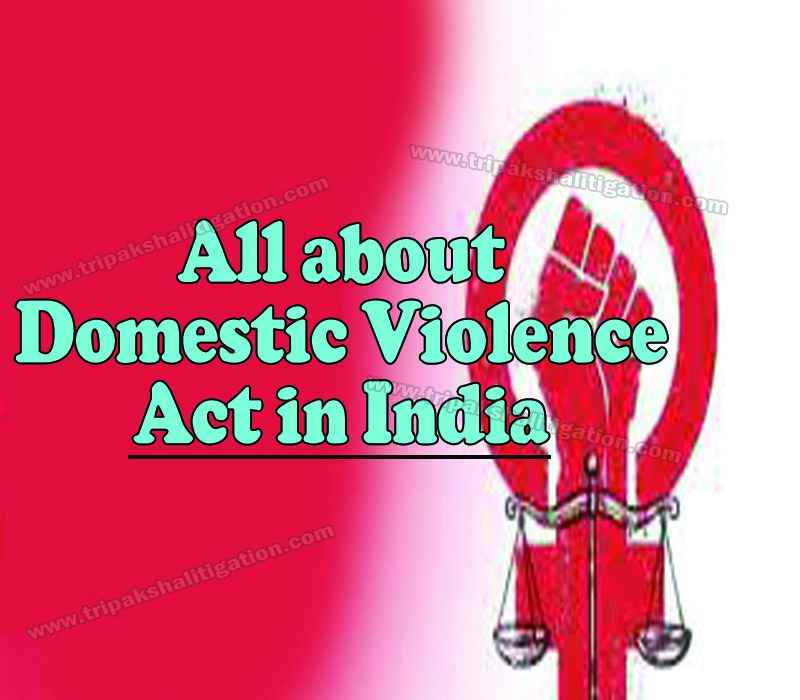Introduction
‘Domestic violence’ is a contradiction in terms. For every human being, home fulfils the basic need of safety shelter. The priority for a person when settling down in life is creating a shelter by owning a house. However, for women, this very house can be a threat to their safety, and dignified living, in fact, sometimes, a threat to their very existence. The threat is so grave that the legislature has been compelled to enact special legislation for their protection, the Protection of Women from Domestic Violence Act, 2005.
Even before the passing of the Act, remedies were available under the penal laws of the country to deal with domestic violence. But the same was not efficacious. The preamble to the Act states that it is “An Act to provide for more effective protection of the rights of women guaranteed under the Constitution who are victims of violence of any kind occurring within the family and for matters connected therewith or incidental thereto.”
The object of the Act
This legislation was brought into force as an attempt to translate into reality the Constitutional guarantee of gender equality and the right to live with dignity. The Act seeks to achieve this objective by-
- Defining “domestic violence” and connected terms;
- Providing machinery to file reports and complaints regarding domestic violence;
- Conferring powers on the Court to pass orders for the protection of the victims of domestic violence and also for adequately compensating them;
- The Act is a piece of civil legislation.
Protection of Women from Domestic Violence Act, 2005
To minimize the cumbersome position of law, be it procedural or substantive, the Protection of Women from Domestic Violence Act, 2005 was enacted to protect the women from acts of domestic violence.
The legislative intent was further emphasized by the Supreme Court of India[i] wherein it was stated that the DV Act is enacted to provide a remedy in civil law for the protection of women, from being victims of such relationship, and to prevent the occurrence of domestic violence in the society. Other legislations like CrPC, IPC, etc., where reliefs have been provided to women who are placed in vulnerable situations were also discussed.
Aggrieved person (Section 2 a)
‘Aggrieved person’ means any woman who is, or has been, in a domestic relationship with the respondent i.e. the person against whom she is filing a complaint under the Act and who alleges to have been subjected to any act of domestic violence by the respondent. Thus following are the two essential conditions–
- The woman must be in a “domestic relationship” with the respondent
- She must make an allegation that she has been subjected to an act of domestic violence by the respondent.
A wife can be an “aggrieved person even after judicial separation[ii].
Domestic relationship (Section 2 f)
A relationship between two persons is treated as a “domestic relationship” if they live or have, at any point of time, lived together in a shared household, when they are related by consanguinity, marriage, or through a relationship like marriage, adoption or are family members living together as a joint family.
The essential ingredients of a “domestic relationship” are-
- Living together in a shared household and
- Being related by consanguinity, marriage or through a relationship like marriage, adoption, or being a member of a family living together as a joint family.
The definition of ‘domestic relationship’ in Section 2(f) of the Act includes not only the relationship of marriage but also a relationship ‘like marriage’. However, all live-in relationships will not amount to a ‘relationship like marriage’.
In D Velusamy v. D Patchaimmal[iii]– The Supreme Court has held that the following requirements (common law marriage requirements) must be fulfilled and the parties must have lived together in a ‘shared household’ for their relationship to qualify as a “domestic relationship”-
- The couple must hold themselves out to society as if they are spouses.
- They must be of legal age to marry
- They must be otherwise qualified to enter into a legal marriage, including being unmarried
- They must have voluntarily cohabited and held themselves out to the world as being akin to spouses for a significant period.
In Indra Sharma v. VKV Sharma[iv]– The Supreme Court has specified the following factors to be considered for determining-
- Duration and period of relationship
- Shared household
- Pooling of resources and financial arrangements
- Sexual relationships, children
- Socialization in public
- Intention and conduct of parties
Thus, wives, mothers, daughters, daughters-in-law, and live-in partners, all are protected under the Act.
Meaning of shared household (Section 2 s)
It means a household where the person aggrieved lives or at any stage has lived in a domestic relationship either singly or along with the respondent. It includes tenanted household or a house which belongs to a joint family of which the respondent is a member.
The Court in the case Ravneet Kaur v. Prithpal Singh Dhingra[v] observed that there existed a frictional relationship between the parties, it would not be advisable for old parents to stay with appellant daughter in law and hence it would be appropriate if an alternative accommodation is provided to the appellant as directed in the impugned order as per sec. 19(1)(f) of the Act. “Thus, where the residence is a shared household, it does not create any embargo upon the owner to claim eviction against his daughter-in-law. A strained frictional relationship between the parties would be relevant to decide whether the grounds of eviction exist”.
Domestic Violence Act
The term is defined in Section 3 of the Act. According to this definition, “domestic violence” can be physical, sexual, verbal and emotional or economic abuse. It can be an act, omission or commission.
According to the National Research Council’s Panel, research was made on ‘Violence Against Women’ which recommended modifying our mindset regarding women’s rights[vi].
Types of Domestic Violence
“Physical abuse” consists of any act or conduct which causes bodily pain, harm or danger to life, limb, or health or impairs the health or development of the aggrieved person. Use of criminal force or assault etc. also amounts to physical abuse. For e .g. severe beating, causing injury with a weapon.
In Smt. Sapna Wd/O Nilesh Patel v. Pravin Ishwarbhai Patel & Others[vii]– A marriage hall, earlier managed by the husband of a widow, is taken away from her by her in-laws and she is deprived of the only source of earning available to her after the death of her husband. The Court held that it amounts to ‘economic abuse’ and is an act of domestic violence.
“Sexual abuse” refers to the conduct of a sexual nature that abuses, humiliates, degrades or otherwise violates the dignity of a woman. It comprises forced sexual intercourse, compelling to watch pornographic material etc.
Verbal and emotional abuse:
It includes-
- Insults, ridicule, humiliation, name-calling and insults or ridicule especially concerning not having a child or a male child; and
- Repeated threats to cause physical pain to any person in whom the aggrieved person is interested;
E.g. repeatedly humiliating wife in the presence of outsiders
Economic abuse:
It includes-
- Depriving the woman of all sorts of financial resources to which she is legally entitled or which she requires out of necessity for running the household, taking care of the children etc.
- Alienation of the movable or immovable assets in which she has interest
- Prohibiting the aggrieved woman or putting a restriction on her to continue the use of resources or facilities.
A marriage hall, earlier managed by the husband of a widow, is taken away from her by her in-laws and she is deprived of the only source of earning available to her after the death of her husband. It amounts to ‘economic abuse’ and is an act of domestic violence[viii].
In-camera proceedings (Section 16)
The ‘in-camera proceeding’ may be defined as the proceeding that is carried out in private, in the absence of the public and the press. Such proceedings are conducted through video conferencing to safeguard the privacy and protection of the accused.
Like other matrimonial litigation, proceedings under this Act can also be conducted in camera if –
- The Magistrate considers that the circumstances of the case so warrant, and
- If either party to the proceedings so desires.
‘Monetary reliefs’ (Section 20)
The Court can direct the respondent to pay monetary relief to the aggrieved person. Such payment is made to meet the expenses incurred and losses suffered by the aggrieved person and any child of the aggrieved person as a result of the domestic violence. It includes the following but is not restricted to the same that is to say, there may be other heads also covered in this order:
- The loss of earnings;
- The medical expense
- The loss caused due to the destruction, damage or removal of any property from the control of the aggrieved person; and
- The maintenance for the aggrieved person as well as her children, if any.
Child custody (Section 21)
Children are the worst sufferers of matrimonial litigation. To minimize hardship to the children, this Act confers power on the Court to grant temporary custody of any child or children to the aggrieved person or the person making an application on her behalf.
If necessary, the arrangements for a visit to such child or children by the respondent are also specified in such orders. If the Magistrate thinks that any visit of the respondent may be harmful to the interests of the child or children, he refuses to allow such a visit.
Rights of an aggrieved person under the Act
Right to reside in a shared household: An attempt is always made to make a woman submit to acts of violence by threatening her to be disposed of or evicted from the house. The Act protects her by empowering the Court to pass an order restraining the respondent from dispossessing or in any other manner disturbing the possession of the aggrieved person from the shared household.
Remedies available to an aggrieved person under the Act (Section 26)
- The Court may direct the respondent to remove himself from the shared household;
- The respondent or any of his relatives can be restrained from entering any portion of the shared household in which the aggrieved person resides;
- The respondent can also be restrained from alienating or disposing of the shared household or encumbering the same;
- The respondent can be restrained from renouncing his rights in the shared household except with the leave of the Magistrate;
- In the alternative, the Court can direct the respondent to secure the same level of alternate accommodation for the aggrieved person as enjoyed by her in the shared household or to pay rent for the same, if the circumstances so require.
- However, no such order can be passed against a woman.
Jurisdiction (Section 27)
(1) The court of Judicial Magistrate of the first class or the Metropolitan Magistrate, as the case may be, within the local limits of which-
- the person aggrieved permanently or temporarily resides or carries on business or is employed; or
- the respondent resides or carries on business or is employed; or
- the cause of action has arisen, shall be the competent court to grant a protection order and other orders under this Act and to try offences under this Act.
(2) Any order made under this Act shall be enforceable throughout India.
In a recent decision, the Supreme Court held that petition under DV Act can be filed in a court where “person aggrieved” permanently or temporarily resides or carries on business or is employed[ix].
Procedure for filing a complaint regarding domestic violence (Section 28)
- The aggrieved person herself or any person who has reason to believe that an act of domestic violence has been committed or is likely to be committed can give information about the same to a protection officer or service provider or the police; Or
- An aggrieved person or a Protection Officer or any other person on behalf of the aggrieved person may present an application to the Magistrate seeking one or more reliefs under the Act;
- The Magistrate fixes the first date of hearing. Ordinarily, this date is not beyond three days from the date of receipt of the application by the Court
- The Magistrate must make an effort to dispose of every such application within sixty days from the date of its first hearing;
- The Magistrate may direct the respondent or the aggrieved person to undergo counselling either jointly or singly;
- Any relief available under this Act may also be sought in any legal proceeding, before a Civil Court, Family Court or a Criminal Court, affecting the aggrieved person and the respondent whether such proceeding was initiated before or after the commencement of this Act.
LANDMARK JUDGMENTS
1. S.R. Batra v. Smt. Taruna Batra[x]
The Supreme Court in this case referred to the definition of shared household and stated that the definition of ‘shared household’ in Section 2(s) of the Act is not very happily worded. The Court t held that under Section 17(1) of the Domestic Violence Act, the wife is only entitled to claim a right to residence in a shared household.
A ‘shared household’ means the house belonging to or taken on rent by the husband, or the house which belongs to the joint family of which the husband is a member. Now, the question is if the property neither belonged to the husband nor was taken on rent by him and not even it was a joint family property of which the husband was a member then in such a case it cannot be considered as a shared household.
2. Lalita Toppo v. State of Jharkhand & anr.[xi]
The Supreme Court has categorically held that maintenance can be claimed under the provisions of the Protection of Women from Domestic Violence Act, 2005 (Domestic Violence Act) even if the claimant is not a legally wedded wife and therefore not entitled to claim of maintenance under Section 125 of Code of Criminal Procedure.
The Bench explained that the provisions contained in Section 3(a) of the Domestic Violence Act, 2005 which defines the term “domestic violence” also constitutes “economic abuse” as domestic violence. The Court further opined that under the provisions of the Domestic Violence Act, the victim i.e. estranged wife or live-in-partner would be entitled to more relief than what is contemplated under Section 125 of the CrPC i.e. to a shared household also.
3. Sandhya Wankhede v. Manoj Bhimrao Wankhede[xii]
In this case, a controversial issue was dealt with, i.e. the definition of the term ‘respondent’ as defined under Section 2(q) of the Domestic Violence Act. A ‘respondent’ is defined as any adult male person who is or has been, in a domestic relationship with the aggrieved person and against whom the aggrieved person has sought any relief under this Act.
However, the Supreme Court in the aforementioned case put to rest the issue by holding that the proviso to Section 2(q) does not exclude female relatives of the husband or male partner from the ambit of a complaint that can be made under the provisions of the Domestic Violence Act. Therefore, complaints are not just maintainable against the adult male person but also the female relative of such adult male.
4. Krishna Bhatacharjee v. Sarathi Choudhury and Another[xiii]
The Apex Court while elucidating on the duty of Courts while deciding complaints under the Domestic Violence Act stated that:
- The Court must scrutinize the facts from all angles to whether a plea advanced by the respondent to nullify the grievance of the aggrieved person is legally sound and correct.
- The principle “justice to the cause is equivalent to the salt of the ocean” should be kept in mind. The Court of Law is bound to uphold the truth which sparkles when justice is done.
- Before throwing a petition at the threshold, it is obligatory to see that the person aggrieved under such legislation is not faced with a situation of non-adjudication, for the 2005 Act as we have stated is a beneficial as well as assertively affirmative enactment for the realization of the constitutional rights of women and to ensure that they do not become victims of any kind of domestic violence.
5. Vimlaben Ajitbhai Patel v. Vatslaben Ashokbhai Patel and ors.[xiv]
In this case, the Court held that when it comes to maintenance of the wife under the Domestic Violence Act read with the Hindu Adoption and Maintenance Act, 1956 it is the personal obligation of the husband to maintain his wife. Property of mother-in-law can neither be the subject matter of attachment nor during the lifetime of the husband can his liability to maintain his wife be directed to be enforced against such property.
Impact on children and domestic violence
Children are the most vulnerable group who are the biggest victims exposed to domestic violence and they are also the victims of physical abuse who are beaten by their parents due to frustration. Children witnessing domestic violence generally experience serious emotional risks as they have a disturbing childhood which leads to mental health issues[xv]. They also face greater risk in managing their future relationships which maybe with their friends, collogue, or spouses. Parents usually forget the impact of fights on their children and they don’t realize that it is difficult to cope with the side effects of domestic violence that they witness. Children get anxious and fearful after seeing fights and disturbances in their homes.
Children are the worst sufferers in matrimonial litigation and they are the aggrieved ones’ when a dispute occurs between their parents. Intend to minimize hardship to the children, this Act confers power on the Court whereby it may grant temporary custody of any child to the aggrieved person and it may also be granted to a person making an application on behalf of the aggrieved. The Court may direct for arrangements for the visit to such child by the respondent are also specified in such orders. The Court also has the discretion to decide whether the grant of the visit is in the interests of the child or children or not, if found dissatisfied then the Magistrate may refuse to allow such visit.
Conclusion
The occurrence of domestic violence cases is very common which not only destroys the life of two people but it destroys the whole family. It hampers one’s personal growth and professional life as well. We always fail to realize that domestic violence ruins the lives of children who have no fault at all but they are the biggest victims of this issue. To deal with it not only parents but educational institutions must also put efforts into giving the proper teachings to children, by making them understand that we should have tolerance towards others and that men/ women have equal standings and none can dominate the other.
Recently, the Apex Court[xvi] has undertaken to expansively interpret the provisions of the DV Act to provide a wider protection within the precincts of the social-welfare legislation. The Court has effectively made space for the rights of the widowed daughters-in-law within remedial functionality of the Act.
[i] Indra Sarma v. V.K.V Sarma, (2013) 15 SCC 755
[ii] Krishna Bhatacharjee v. Sarathi Chaudhuri, 2016 CrLJ 330
[iii] AIR 2011 SC 479
[iv] AIR 2006 SC 2522
[v] 2022 LiveLaw (Del) 151
[vi] Crowell and Burgess, 1996
[vii] Bombay High Court on 3rd May 2019
[viii] Smt. Sapna Wd/O Nilesh Patel v. Pravin Ishwarbhai Patel & Others , Bombay High Court on 3rd May, 2019
[ix] Shyamlal Devda v. Parimala, (2020) 3 SCC 14
[x] 2007(1) RCR (Crl) 403(SC)
[xi] Cr Appeal No. 1656/ 2015, Judgment given in 2018
[xii] AIR 2011 SC (Criminal) 567
[xiii] [SLP(Crl) No. 10223 OF 2014)]
[xiv] [AIR 2008 SC 2675]
[xv] (Gargour, 2014)








